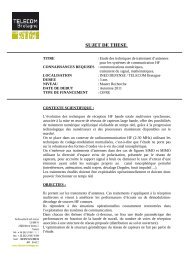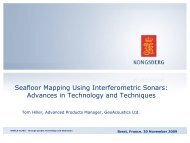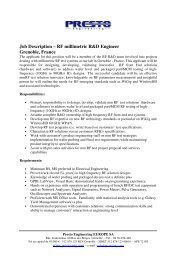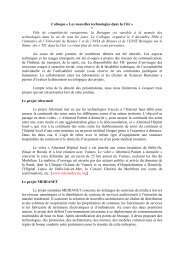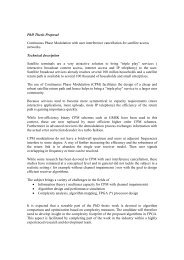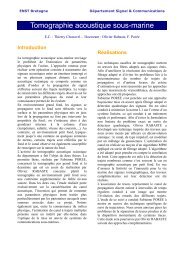Département Réseau, Sécurité et Multimédia Rapport d'Activités 2008
Département Réseau, Sécurité et Multimédia Rapport d'Activités 2008
Département Réseau, Sécurité et Multimédia Rapport d'Activités 2008
Create successful ePaper yourself
Turn your PDF publications into a flip-book with our unique Google optimized e-Paper software.
Radio Resource Management in WirelessN<strong>et</strong>worksWiMAX Radio Resources Management and Capacity EstimationResearch Staff : Xavier Lagrange, Patrick Maillé, Loutfi Nuaymi – Ph.D. Student: Aymen BelghithKeywords : WiMAX, scheduling, QoS, capacity estimation, resource management, pricingApplications : Wireless Intern<strong>et</strong> AccessPartners & Funding : Region Br<strong>et</strong>agneIntroductionWiMAX (Worldwide Interoperability forMicrowave Access) Broadband Wireless AccessTechnology is based on 802.16-2004 standardand its amendment 802.16e [1].This standard defines the physical (PHY) andmedium access control (MAC) layer for fixedand mobile broadband wireless accesssystems. Devices s<strong>et</strong> up a so-called serviceflow to transfer data. A service flow is a MACtransport service that provides unidirectionaltransport of pack<strong>et</strong>s with a given quality ofservice either on uplink (pack<strong>et</strong>s transmittedby the SS, Subscriber Station) or on downlink(pack<strong>et</strong>s transmitted by the BS, Base Station).The dynamic service management is used toadd a new service flow, change the QoSparam<strong>et</strong>ers of an existing flow service anddel<strong>et</strong>e an existing service flow.WiMAX radio resource system is very open andmany algorithms are important for capacity:admission control, scheduling, power control,pricing, <strong>et</strong>c. In this work, we intend to studysome parts of WiMAX radio resourcemanagement and then propose estimations ofWiMAX capacity for some scenarios andenvironments. This work is made in theframework of a PhD study with partial fundingof Région Br<strong>et</strong>agne.includes many tools. Classical schedulingalgorithms such as Round Robin, Max SIR(Signal-to-Interference Ratio) can be adaptedor associated with other algorithms forWIMAX. Another trend is to define schedulingalgorithms specifically for WiMAX.An important software development effortallowed the integration of various MACfunctionalities in an existing NS-2 (N<strong>et</strong>workSimulator) WiMAX module [2]. We introducedseveral WiMAX QoS features and theimplementation of some schedulers and theevaluation of some param<strong>et</strong>ers. Our modifiedWiMAX NS-2 module is described in d<strong>et</strong>ail in[3]. New interesting simulation results aboutWiMAX scheduling were obtained and will bepublished in [4]. The spectrum efficiency andmean sojourn time performance measures ared<strong>et</strong>ermined through simulations. Spectrumefficiency is plotted for different schedulers(see Fig.1). We verify that scheduling based onthe maximum SIR (mSiR)) scheduler providesthe highest spectrum efficiency and the worstdelay to deliver data frames, independently ofthe quality of the channel.RealizationFirst, a study of dynamic service managementhas been realized. The power control in theWirelessMAN-OFDM PHY layer has beenstudied. The power control has two stages: theinitial calibration and the periodic adjustmentprocedure. Then, a review of WiMAXscheduling techniques has been made. TheWiMAX scheduling environment as defined inthe IEEE 802.16 standard is very open andFuture WorkFig.1: Spectrum efficiencyOther WiMAX scheduling studies are currentlyfinalized and will be submitted to two Researchconferences.Pracom’s Annual Report <strong>2008</strong> 17




